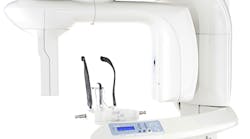Independent study recognizes extreme low dose capabilities of Carestream Dental’s CS 9300 Low Dose Mode
Recent studies have confirmed that the CS 9300 family of cone beam computed tomography (CBCT) systems can provide 3D exams at up to 85 percent lower dose than traditional 2D panoramic imaging. The research, conducted by John Ludlow, DDS, of the University of North Carolina’s School of Dentistry, Chapel Hill, found that 3D images captured using the Low Dose Mode for a 5x5 cm adult exam provides an effective dose of just 3 microsieverts (µSv)1.
Dose-saving algorithms and noise reduction processing enables the new Low Dose Mode to drastically reduce the dose and scanning time of the CS 9300—between 73 and 95 percent as compared to standard acquisition mode2—while maintaining diagnostic image quality. Low Dose Mode is available for 17x11 cm down to 5x5 cm scans and covers multiple applications such as implant planning; follow-up exams for orthognathic, maxillofacial surgery or implant; analyzing skeletal symmetry; assessing airways; evaluating impacted teeth and supernumeraries; and pediatric examinations.
“We all naturally absorb about 2,400 µSv of radiation per year from our surroundings,” Ed Shellard, DMD, chief commercial officer, Carestream Dental, said. “Low Dose can optimize the dosage to just 3 µSv for a 5x5 cm adult exam, or less than half a day’s equivalent background radiation. This is ideal for pediatric or follow-up examinations, which allows the practitioner to prescribe the image quality required while adhering even more to the ALARA [As Low as Reasonably Achievable] Principle.”
An additional benefit of the new Low Dose Mode is that existing units in the CS 9300 family can easily be retrofitted with the module, so that doctors can ensure they’re treating their patients with the lowest dosage possible.
“We want doctors to rest assured that they’re always using the safest and most advanced technology when treating their patients with Carestream Dental equipment,” David Roudergues, director of U.S. dental equipment, product line manager, Carestream Dental, said. “The Low Dose module allows practices to easily update their existing equipment and operating systems, without the burden of purchasing a whole new unit.”
Along with reduced radiation, the CS 9300 offers exceptional 3D imaging technology and leading 2D digital panoramic imaging with variable focal trough technology. One-shot cephalometric imaging is available as an optional feature. The system produces an image resolution of up to 90 µm with 1:1 accuracy, delivering superior diagnostic detail. Additionally, the CS 9300 features medium to large field 3D imaging with seven selectable fields of view, ranging from 5 cm x 5 cm to 17 cm x 13.5 cm. These fields of view support a wide variety of clinical applications, such as implantology, oral and maxillofacial surgery, orthognathics and orthodontics.
The CS 9300 family also includes the CS 9300 Select, which offers medium field 3D imaging with four fields of view. As with the CS 9300, the CS 9300 Select is also available with an optional cephalometric arm. Both the CS 9300 and the CS 9300 Select can be easily upgraded with the Low Dose module.
For more information about the Low Dose imaging or the CS 9300 family, please call 1.800.944.6365 or visit www.carestreamdental.com.
1. Based on studies conducted by John B. Ludlow, University of North Carolina, School of Dentistry: Dosimetry of CS 8100 CBCT Unit and CS 9300 Low-Dose Protocol, August 2014; Dosimetry of the Carestream CS 9300 CBCT unit, June 2011. 85% reduction (3µSv) found in 5x5 cm adult exams; exact dose reduction varies based on field of view and ranges from 0% to 85%.
2. Based on study conducted by John Ludlow, University of North Carolina, School of Dentistry, Dosimetry of CS 8100 CBCT Unit and CS 9300 Low-Dose Protocol, September 2014
Related Articles
Product spotlight: CS 9300 takes the guesswork out of examinations
What are dental students taught about CBCT?






